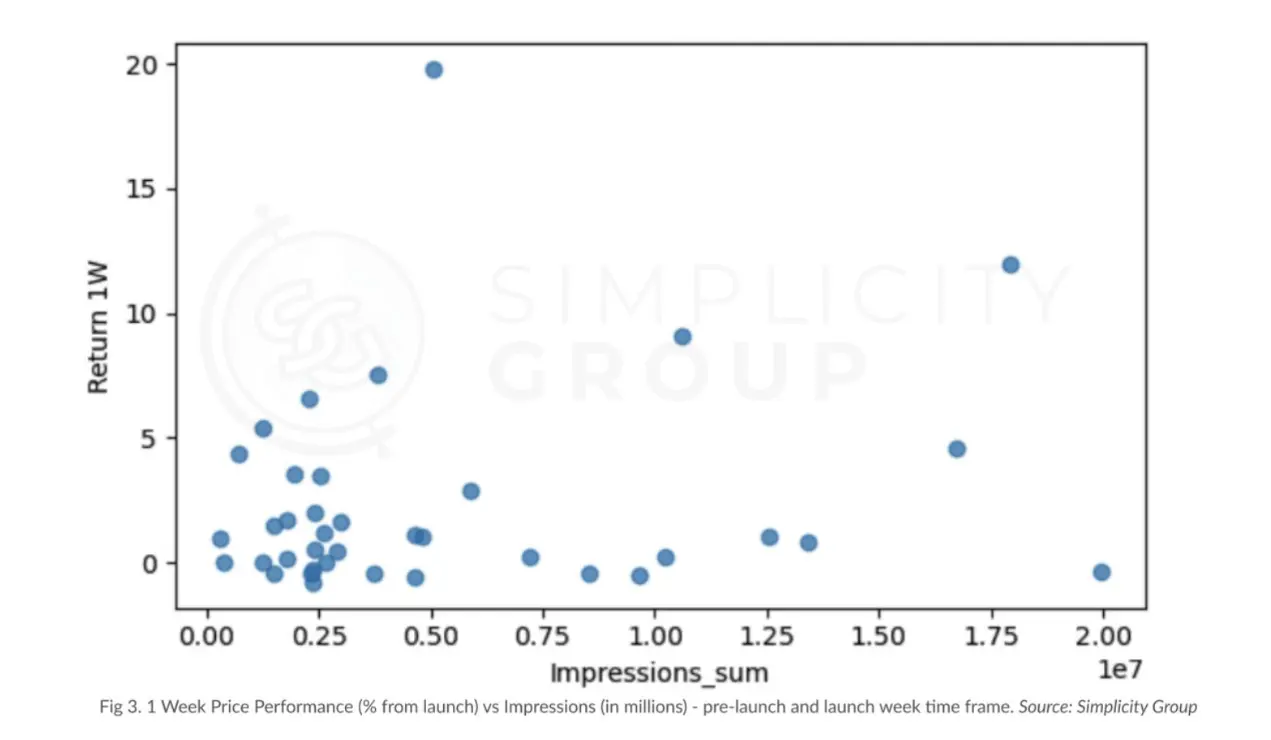Focusing on building products, reasonably pricing tokens to avoid overvaluation, sincere communication, and discarding vanity metrics are key to a project's successful TGE.
Author: rosie, Crypto KOL
Compiled by: Felix, PANews
Crypto Twitter (CT) always loves to tell you how to launch a token: like first accumulating 100,000 followers, increasing engagement through tasks, raising funds from tier-one VCs, controlling the circulating supply to 2% at launch, and maximizing hype during the week of the token generation event (TGE).
The problem is: it’s all nonsense.
Simplicity Group recently released a research report analyzing 50,000 data points from 40 major token launches in 2025, and the findings show that the traditional methods touted on CT do not work in actual token launches.
The Lie About Engagement
Everyone (including the author) is obsessed with various metrics on Twitter. Likes, retweets, replies, impressions—all these vanity metrics. Project teams spend thousands of dollars on engagement farming, task platforms, and buying followers.
The correlation with price performance within a week: almost zero.
Simplicity Group's regression analysis shows that the correlation coefficient R² between engagement metrics and price performance is only 0.038. In short: engagement hardly explains token success.
Likes, comments, and retweets are actually slightly negatively correlated with price performance. This means that projects with higher engagement sometimes perform worse. GoPlus, SonicSVM, and RedStone continuously post content, but their user engagement does not correlate with their user base.

The only metric that shows a positive correlation is surprisingly the number of retweets in the week before launch. The p-value coefficient is 0.094, which is almost statistically insignificant, but even so, the correlation is weak.
So, when you spend money on buying bots and meticulously planning complex task activities, you are essentially just "burning money" in a meaningless way.
The Myth of Low Circulation
CT is obsessed with projects that have "low circulation and high FDV." The idea is: launch with a very small circulating supply to create artificial scarcity, and then watch the price soar.
But it turns out to be wrong again.
The percentage of initial circulating supply relative to total supply has no correlation with price performance. Research shows that it has no statistically significant correlation at all.
What really matters is: the dollar value of the initial market cap.
R² is 0.273, and the adjusted R² is 0.234, indicating a clear relationship: for every unit increase in initial market cap (IMC), the return rate one week later decreases by about 1.37 units.
In short: for every 2.7 times increase in initial market cap, the price performance in the first month decreases by about 1.56%. This relationship is so tight that it can almost be considered causal.
The lesson: the key is not the proportion of unlocked tokens, but the total dollar value entering the market.
The Illusion of VC Support
“Wow, they raised $100 million from a16z, this is definitely going to skyrocket!”
Narrator: It did not skyrocket.
The correlation between the amount of funding and one-week return rate is 0.1186, with a p-value of 0.46. The correlation between the amount of funding and one-month return rate is 0.2, with a p-value of 0.22.
Both are statistically insignificant. The amount of funds raised by a project has no actual relationship with the performance of its token.
Why? Because the more funds raised, it usually means a higher valuation, which means needing to overcome greater selling pressure. Extra funds do not magically translate into better tokens.
However, CT treats funding announcements as buy signals. It’s like judging a restaurant's quality based on the rent paid by the owner.

A perfect example: projects that raised large amounts of funding in the study did not necessarily perform better than those with limited funding. A $100 million funding amount does not guarantee better token economics or a stronger community than a $10 million funding amount.
The Timing of Hype Fallacy
The traditional view is to save the most important news for the project launch week to maximize the "FOMO" atmosphere and attract everyone's attention when the token goes live.
But data shows the opposite is true.
User engagement declines after the project launches. Users turn to the next project with an airdrop, and your carefully prepared content gets ignored.
Projects that can maintain good performance continuously built their reputation before launch week, not during it. They understand that pre-launch attention brings real buyers, while attention during launch week only brings "bystanders." User engagement peaks before the TGE when they release launch teasers, not after launch when everyone has moved on to the next opportunity.
What Really Works
Since Twitter engagement, low circulation, VC support, and timing of hype are not important, what is?
Actual Product Utility
Projects that generate content naturally (like Bubblemaps with on-chain survey features or Kaito with narrative tracking capabilities) perform better than meme-focused accounts. Bubblemaps and Kaito have substantial and sustained user engagement because their products can naturally create alpha-full content.
Transaction Retention Rate
Tokens that maintain trading volume after the initial hype show significantly better price performance. The Spearman rank correlation coefficient (PANews note: a non-parametric measure of the dependence between two variables) is -0.356 (p = 0.014)—tokens with a significant drop in trading volume tend to perform worse in price. In the first month after issuance, the top quartile of trading volume retention has significantly higher median and mean price performance.
Reasonable Initial Market Cap
The strongest predictive indicator of success. The correlation coefficient is -1.56 and statistically significant. Launching at a reasonable valuation gives you room for growth. Launching with a market cap over $1 billion is going against the trend.
Real Communication
A consistent tone that matches the product. Powerloom's $5.2 million funding and overly cynical tone are not in harmony—POWER plummeted 77% in the first week and has since dropped 95%. Meanwhile, Walrus tweeted in a sincerely humorous way, and a month later, the token price increased by 357% after the TGE. Hyperlane maintained pragmatic updates, soaring 533% in the first week.
Why CT Gets It Wrong
This disconnect is not malicious but structural.
CT rewards engagement rather than accuracy. Posts about "10 ways to achieve 100x token launches" get more retweets than "what the data actually shows."
KOLs accumulate followers by "catering" to projects rather than challenging them. Telling users that their engagement farming is meaningless does not yield returns.
Moreover, most KOLs on CT have never actually launched a token. They are just commenting on a game they have never played. In contrast, projects like Story Protocol that genuinely launch products consistently perform well, regardless of their Twitter follower count.
The Real Meta
Here are the actual practices of successful projects (according to the data):
Focus on building products that people want to use
Price tokens reasonably at launch
Communicate sincerely with the audience
Measure what truly matters, not just likes
This is absolutely revolutionary.
Take Quai Network as an example—they focus on technical explanations and educational posts about their unique blockchain consensus model. During the TGE, they averaged about 24,000 views. QUAI rose 150% in the first week after launch. This was not because they had millions of followers, but because they genuinely sparked interest in their innovation.
In contrast, projects that burn money on task platforms and engagement farming see their tokens plummet because no one truly understands or cares about what they are building.
Ironically, while everyone caters to the Twitter algorithm, the ones that truly succeed are those quietly building useful things and releasing them wisely.
Case study: Zora failed to disclose tokenomics details in a timely manner, leading to a 50% drop a week after the TGE. Meanwhile, projects that adopt transparent methods and focus on product-driven content consistently perform well.
CT does not intentionally lie. But when the incentive structure rewards popular opinions over hard data, useful information gets drowned out in the noise.
免责声明:本文章仅代表作者个人观点,不代表本平台的立场和观点。本文章仅供信息分享,不构成对任何人的任何投资建议。用户与作者之间的任何争议,与本平台无关。如网页中刊载的文章或图片涉及侵权,请提供相关的权利证明和身份证明发送邮件到support@aicoin.com,本平台相关工作人员将会进行核查。




